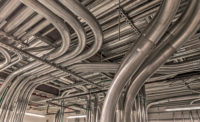
The Sixth Street Viaduct Bridge in Los Angeles—the site of numerous Hollywood movie scenes—has reached the end of its career. City engineers are reviewing a request-for-proposals document for a final cable-stayed design to replace the structure, which consists of two prestressed-concrete viaducts and a double steel-arch center span.
"The bridge is very sick," says Tonya Durrell, an agency spokeswoman. "It has alkali-silica reaction," or ASR. She says ASR can resemble a chronic disease, ongoing and irreversible. In ASR, the silica in the aggregate of a concrete structure breaks down, creating a gel that takes on water and expands. The concrete cracks from the pressure of the expanding gel.
In 2004, studies determined that with the current rate of deterioration, the bridge, which opened in 1932, has a 70% possibility of collapse in a significant seismic event over the next 50 years. The city is carefully monitoring the bridge, which continues to be open to traffic, says John Koo, city project manager. He says an RFP for final design of the new bridge will be released in the near future.
The Los Angeles City Council voted late last year to replace with a cable-stayed bridge the 3,500-ft-long, 46-ft-wide viaduct just east of downtown. The Dept. of Public Works will short-list the top three designs from the RFP respondents.
Listed on the California Register of Historic Resources, the viaduct is the only one of the many bridges over the Los Angeles River to have the fatal condition. "We now know how to proportion the concrete mixture so you don't get ASR," says Rachel Detwiler, an engineer and editor-in-chief of the Precast/Prestressed Concrete Institute Journal. "But at the time that the bridge was built, they did not know about alkali-silica reaction."
The $401-million, mostly federally funded replacement bridge will take shape in three years, after the design gets finalized with community input. Once construction begins, the new bridge is scheduled to be completed in about four years and will include wider sidewalks with room for pedestrians and cyclists.


